As a project to transcribe and digitise dozens of Humphry Davy’s notebooks draws to a close, researchers are piecing together a complicated picture of one of chemistry’s most influential figures. The Davy Notebooks Project, led by academics at Lancaster University, UK, has brought new insight into the life and mind of the celebrated scientist, who discovered more chemical elements than any other person before or since. By analysing Davy’s writings, the researchers have gathered firsthand evidence of the scientist’s excitement upon his discovery of potassium, his fondness for laughing gas and love of fine tailoring, as well as a darker, less well-known side of one of chemistry’s giants.
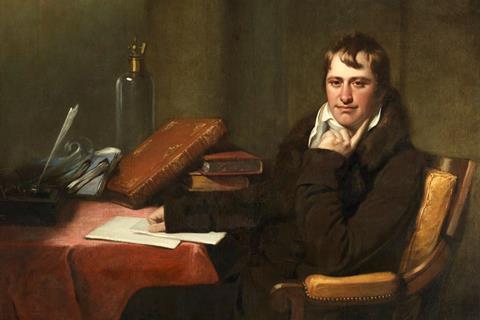
The Davy Notebook Project began back in March 2019, when a pilot project recruited volunteers via the citizen science platform Zooniverse to transcribe five of Davy’s notebooks.
‘We did it in two months or so, it was really, really quick,’ says Sharon Ruston who heads up the project team. ‘We actually got eight notebooks done in the time that we had – and so it was a huge success.’
A £1 million grant followed to help the project transcribe the remaining 75 notebooks that Davy kept throughout his life – covering everything from his work on the famous Davy lamp to his notes on agricultural projects and more. In total around 3500 volunteers helped to transcribe more than 11,400 pages of text. The full digital archive will be published online and made freely accessible to the public on the Lancaster Digital Collections website this summer.
The Davy Notebooks project
This long-running citizen science project has uncovered new insights into Davy’s life. Ellie Bird, a historian on the project discusses her thoughts on how we should curate Davy’s legacy.
We look at what Humphry Davy’s notebooks reveal about his life and work.
‘Often there’s poetry and science and all sorts of other things: gossip about famous people, his reading lists, his shopping lists and all sorts of stuff,’ says Ruston. The project has uncovered hundreds of poems written by Davy, revealing just how important this was as a creative outlet for him. ‘There’s some really good bits where you can see he’s working out the metre of things, or he’s working out rhyming words – so it’s a craft he does work at,’ notes Ruston.
Davy would often intersperse his technical writing about his latest experiments with lines of poetry. ‘There’s one page where he is definitely in the lab writing poetry, because you’ll have a page where there’s science, and then there’s poetry on the same page, and the page itself is burned.’
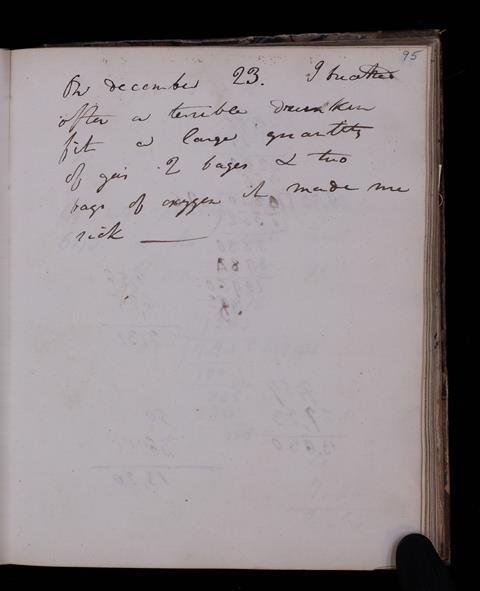
At least one of the poems deals with Davy’s use of nitrous oxide, which is today known widely as laughing gas. Davy was the first person to inhale laughing gas, and early in his career he would espouse the chemical’s benefits, believing it to be a cure all for many different ailments. Ruston notes that Davy would even curate experiences where he could take the drug in idyllic settings like the Wye Valley. But Davy’s analytical mindset still applied in these situations.
‘He used a notebook to record every time he took it and he tried taking different quantities and accompanying it with different things,’ says Ruston. ‘There’s one bit where he says: “I drank a whole bottle of wine, then I had six quarts of nitrous oxide, then I was sick.”’
‘And there are times when he’s completely off his head – one bit I really like is when he’s had loads of nitrous oxide and he writes “Davy and Newton” in really big letters, which is clearly quite self-aggrandising!’
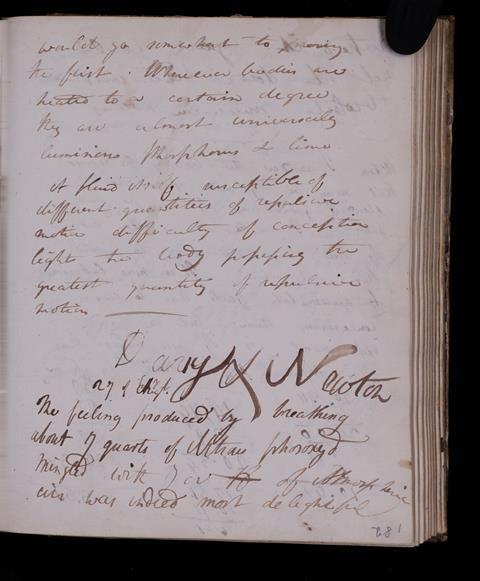
From a scientific perspective, perhaps one of the most important moments captured in the notebooks comes when Davy makes his discovery of potassium. An account from Davy’s lab assistant has previously told how Davy had danced around the room in delight when he first isolated the element. And the notebooks give even more insight into Davy’s initial reaction to the discovery.
‘He doesn’t call it potassium for quite a while; he tries out different names – he tries potarchium and sodarchium and there’s another one as well before we get to potassium,’ explains Ruston. ‘And in the middle of that first page, there’s an address, really randomly. But our research associates identified that that was a tailor – so we reckon that he got so excited that he was thinking: “This is what I’m going to be talking about in the Bakerian [prize lecture] next year at the Royal Society. I need a new suit!”’
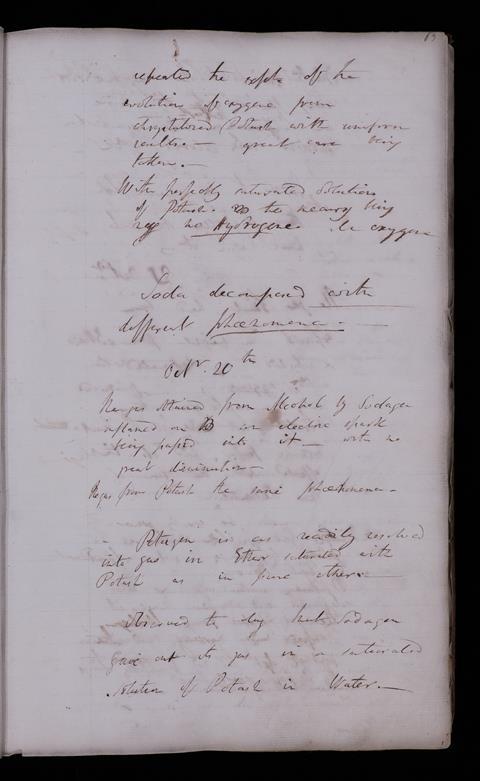
A darker side to Davy
Ruston notes that while the notebooks project has enabled the researchers to learn much more about Davy than would have been possible from other sources, not all of it has been positive.
In the 1820s Davy was asked by the Royal Navy to find a way to stop the copper bottoms of its ships corroding. As a pioneering electrochemist, Davy’s solution was to galvanise the material with zinc or iron layers that he dubbed ‘Davy’s protectors’. While the protectors did prevent corrosion, a side effect was that barnacles and seaweed could now adhere to the naval ships and impede their ability to steer. Ruston notes that Davy ‘got really angry’ about the criticism that followed.
Around this time, the metallurgist Robert Mushet put forward a similar idea, which he also patented. According to Ruston, the notebooks project team has uncovered a satirical poem penned by Davy in the style of Byron’s Don Juan that ‘is basically dissing Robert Mushet’s patent ’. This dismissive attitude towards a perceived rival echoes Davy’s hostile reaction towards George Stephenson who famously invented the Geordie lamp – a miner’s safety lamp developed around the same time that Davy created his own ‘Davy lamp’.
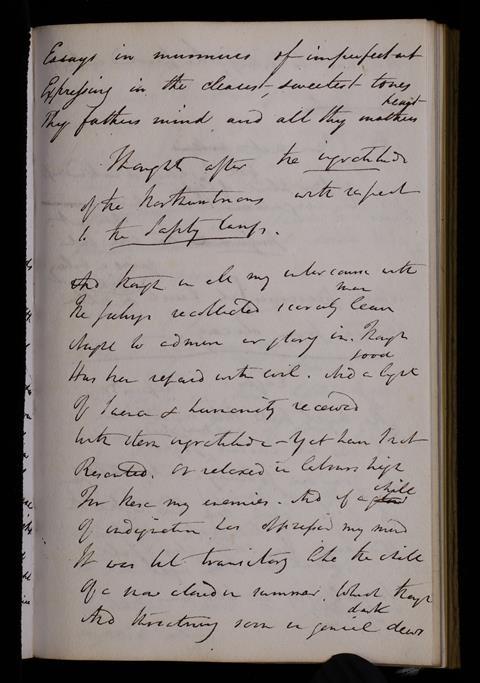
Another scientist with whom Davy had strained relations was Michael Faraday, who at various points in his career Davy employed as an assistant. Many pages of the notebooks were actually penned on Davy’s behalf by Faraday, as well as other scribes who at times worked for Davy.
‘It’s a deeply complex relationship, and it lasts from their first encounter in 1812 really through to Davy’s death in 1829, although they interact far, far less in the late 1820s than before,’ explains University College London science historian Frank James, another member of the notebooks project team. ‘And basically Davy gave Faraday a job in science for which Faraday was very grateful. But Davy came not to like that Faraday was doing work that was going to eclipse Davy’s own reputation. Davy’s got such a huge ego – there’s a sort of strong psychological motivation.’
According to James, Davy’s treatment of Faraday could often be seen as exploitative. One example he points to is when Davy asks Faraday to accompany him on a European tour in place of his valet. ‘In a very class-conscious society doing the function of a valet makes you into a servant, whereas Faraday’s other duties on the tour as amanuensis and assistant were not servant-type roles,’ says James.
‘There’s a very, very thin line between exploitation and patronage – in patronage, both sides should gain something from the experience, in exploitation only one side. And Davy does seem to be on this exploitative side more than anything else,’ he adds. ‘But that said, he does secure for Faraday positions like director of the laboratory at the Royal Institution in 1825.’
Davy and race
Beyond the suggestions of Davy’s egotism and ill-temper, the notebooks project is also raising much more serious questions about Davy’s legacy. Eleanor Bird is an expert on the transatlantic slave trade during the Romantic era and was brought onto the project to look at Davy and his attitudes to race.
‘Davy was the most celebrated chemist of his day in Britain and for too long, I think, he’s been kept out discussions of race and how racism developed within the Romantic era,’ she notes. ‘And it seems, the more I dug into it, the more this feels like an oversight.’
Bird explains that early in the project some of the volunteers uncovered ‘derogatory language’ relating to Black Africans in a notebook that Davy used as a teenager. ‘This alerted the wider project to the fact that there would be content in the notebooks that needed looking at,’ she says. ‘I’ve spent a lot of time exploring that essay, and in it Davy seems to be talking about how humans can change according to their environments. But when he comes to talking about African people, he has a much harder sense in his language – he talks about them as being “almost incapable of improvement ”.’
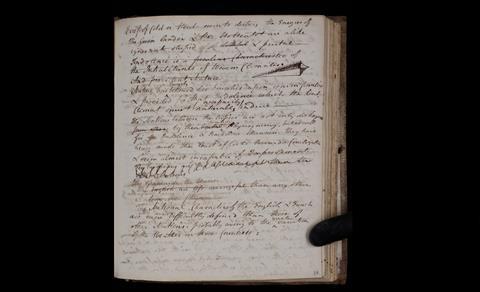
‘I’m quite cautious around using the term “racist” in this context because ideas around race were really multifaceted and shifting in the period that he was writing. And it’s kind of anachronistic to use that term specifically, but it’s also useful because we understand what’s meant by that,’ adds Bird. ‘And it is a kind of proto-racist moment for Davy – he’s already separating Black African people out from other humans saying that they are less capable of altering and changing according to their environment.’
Bird notes that Davy appears to have retained these views in adulthood and continued to express ideas about the superiority of white Europeans in a notebook dating from 1829 – the last year of his life.
Bird’s findings on Davy and race are currently in press, due to be published later this year. Her research has shone a spotlight on the fact that a significant portion of Davy’s wife’s fortune came from the slave trade. She notes that while many of Davy’s contemporaries were beginning to call for the abolition of the slave trade – a major political concern of the era – Davy himself is ‘almost totally silent’ on the issue.
Bird also notes that some of Davy’s close peers are known to have carried out horrendous experiments on the causes of skin colour that involved bleaching and burning the skin of Black people. While there is no evidence that Davy himself was involved in such experiments, he was perceived at the time as an expert on skin pigmentation and his views were sought by other researchers whose own work would be deemed wholly unethical today.
‘He’s very much kind of part of these conversations and he’s consuming those ideas,’ adds Bird. ‘What is interesting is that, given what we’re now learning about how embroiled Britain was in slavery and the slave trade in the 18th and 19th centuries … what’s kind of surprising is that Davy hasn’t been discussed as part of that world.’
‘We’re not saying he’s necessarily exceptional. But [with] his immediate family links to slavery and his work on skin colour and his difficult views that hardened into what I would describe as a kind of racism – I think it’s interesting that this aspect has been ignored for Davy for so long,’ she adds.
According to Bird, the fact that questions around Davy and race are now being asked ‘reflects the sea change in scholarship and the availability of understanding around’ these issues. ‘UCL’s work Legacies of British Slavery and their database, and the national conversation that’s going on, is making it possible – and impossible not to now start thinking about Davy in that way.’





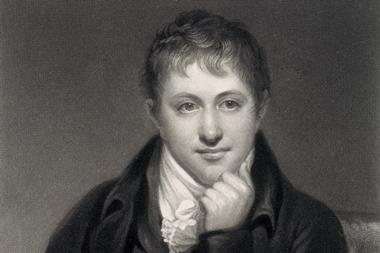
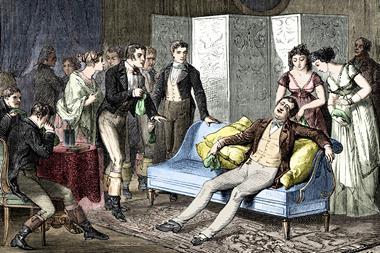

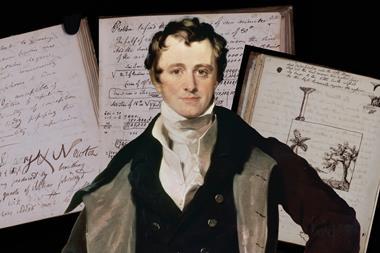








No comments yet